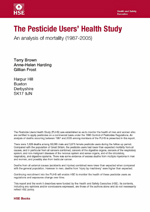If you want to generate news, an almost surefire way to garner headlines and media attention is to come out with a study associating something with a higher risk or incidence of cancer. If you don’t want to appear on the crawl at the bottom of CNN, a great way to ensure a media blackout is to do just the opposite—come out with a study that turns conventional wisdom on its ear by reporting that pesticide applicators have a lower incidence of cancer mortality than the general population.

Those counterintuitive results are exactly what Great Britain’s Health and Safety Laboratory (HSL) found in its
Pesticide Users Health Study (PUHS), which examined mortality among commercial pesticide applicators and other workers with chronic occupational exposure to pesticides between 1987 and 2005. During that timeframe there were 1,628 deaths among 59,085 male and 3,875 female pesticide users. Compared with the population of Great Britain, the pesticide workers had statistically significant lower than expected mortality from all causes of death, and in particular from all cancers combined.
The study found that mortality from major disease groups, including all cancers combined, cancers of the lip, oral cavity and pharynx, cancers of the digestive organs, cancers of the respiratory system, non-malignant diseases of the nervous system and sense organs, and non-malignant diseases of the circulatory, respiratory and digestive systems, were statistically significantly lower than mortality in the Great Britain population. It did not take other lifestyle factors into consideration. Nevertheless, the study’s authors speculate that the “healthy worker effect, and higher occupational physical activity levels and lower smoking rates in this group of workers, may explain these lower than expected mortality rates to some degree.”
The PUHS found some evidence of excess deaths from multiple myeloma in men and women, and possibly also from testicular cancer, but the evidence from the mortality analysis for these excess deaths was “relatively weak,” the study’s authors noted. The authors point out that the overall findings are limited due to the fact that only information on mortality and cancer incidence among the pesticide users was available. The authors note that a significant number of non-life threatening diseases, such as respiratory diseases, may be associated with pesticide exposure and agricultural work where most exposure occurs. They suggested that a general health survey of the pesticide users would be of value and help determine the occurrence and associated risk factors of various health conditions among the pesticide users. None of these factors, however, should detract from the main headline, which is to say that a new study finds British pesticide workers have lower cancer mortality than the general population.
The
Competitive Enterprise Institute had an interesting take on the Pesticide Users Health Study. “Does this mean that working in the pesticide industry reduces your cancer risks?” CEI blogger Angela Logomasini wrote. “Not really, but it does raise questions about activist claims about cancer risks posed by pesticides, particularly when they suggest that consumers, who have much lower exposures than workers, face substantial risks.” Furthermore, she added, “there’s little evidence that pesticides are a significant cause of cancer even among some of the most exposed populations. There is plenty of evidence, on the other hand, that these products serve important public health and agricultural values.”
The HSL is an agency of the U.K.’s Health and Safety Executive (HSE), which is similar in scope to the Occupational Safety and Health Administration in the U.S. The independent regulator seeks to reduce work-related death and serious injury across British workplaces. The PUHS included men and women who have been certified to apply pesticides on a commercial basis in Great Britain and who agreed to take part in HSE’s research into their health.